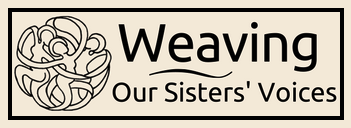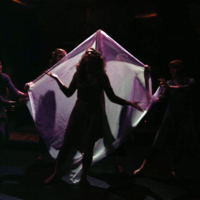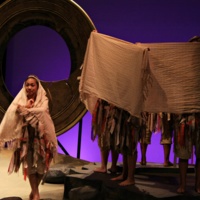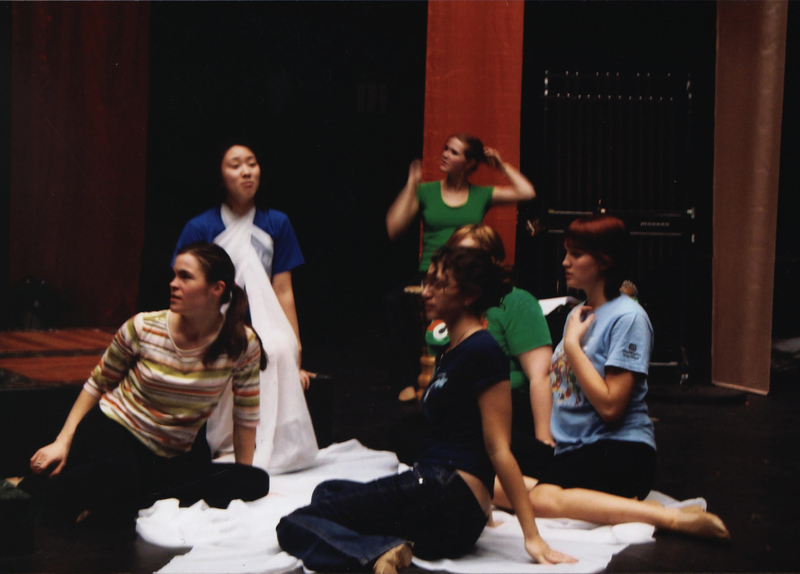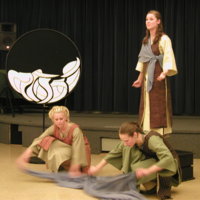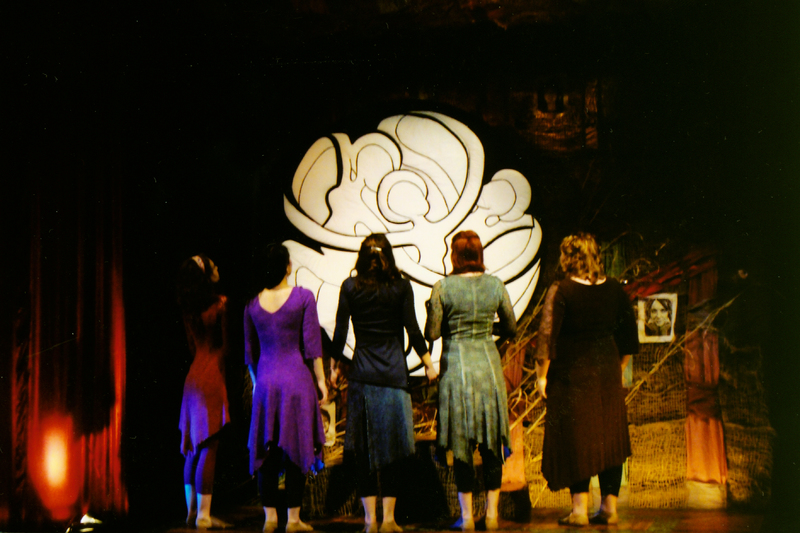Enhancements of Live Music
The score for Weaving Our Sisters’ Voices also heralded back from the Medieval Mysteries production. Robert Spittal, from the Gonzaga Music Department, and I had a fruitful collaboration when we developed the musical score for the Medieval Mysteries. At the time, Bob was interested in working on movie scores, and he composed all of the music on synthesizers he had set up in an attic studio in his home. I enjoyed the creative process of developing music from moods and images; I found I had to trust my instincts when making early decisions about the lengths and intentions of the songs.
The other musical element was a triangle ‘ding’ at the end of each story prior to the actors picking up the puzzle piece and placing it up on the medallion. This simple sound of a chime created a powerful moment of transition for the performers and audience to reflect on the story they just heard, and how its telling became another step in the metaphorical healing of the Levite’s Concubine by putting the medallion back together.
For the 2010 Production, we were in the Magnuson Theatre where our mainstage productions performed. In addition to Bob’s beautiful score, I chose to take what we had done with the simple triangle for the tour and work with two additional students as our musicians in the ensemble. One student was a music major and the other a theatre major. They became a very important part of the mood that was created as well as creating transitions between the stories. I decided to have them visible and on stage the entire time - not to perform as characters, but as the sound scape of the ensemble. We certainly used Bob’s musical score, but in the theatre it worked to have the live sounds more fleshed out. This created an interesting challenge for the set design which is highlighted in "Reiteration and Design: Costuming and Set"
It’s also notable that one of our musicians for the 2010 production was male. I toyed with the idea of him speaking the lines, but I knew that with him on stage and just being a voice of the male character and not actually engaged physically in the scene, would cause greater divide for the audience’s focus. Men had certainly been a part of the production, with Robert Spittal’s score, John Hofland’s set design and other male students help in building the show, but having a man on the stage for the performance felt a better balance to me.
Then for the 2015 production, we had the pleasure of developing the music even further. Bob and I knew that while the score had worked for the 2006 Tour and 2010 Production, we were both interested in developing further musical elements for a number of the scenes.
The story of Tamar is a tricky one. She is denied her right to marry her dead husband’s brother. To ensure her survival as a twice widowed woman, she veils herself and her father-in-law, thinking Tamar is a prostitute, has sexual intercourse with her and impregnates her. In order to represent the moment of the two of them in the tent, in the 2010 Production, the live musicians created a short percussive sequence. For the 2015 Production, Bob and I developed it further into a song that combined her desperation and necessity.
Similarly with the story of Vashti, there is a considerable amount of action that happens in a short number of lines:
After reigning for three years my husband held a party,For 180 days he paraded his wealth before his officers and subjectsWhen all the ‘showing off’ was done, he held a seven day ‘banquet.’Hmmph – drinking contest would be a better name for it!Where was I during these week long festivities?I held my own banquet – with the women.Imagine my surpriseAs we were finishing dinnerSeven eunuchs came in and demanded I accompany themWSV NOT an Object
In just eight lines, the setting, background, and initial conflict are all explained. So we developed a song that could give the sense of reigning royalty as well as the women’s banquet complete with dancing and merriment. This way, when silence came at the end of the number and the eunuchs entered with demands the scene felt even colder in contrast.
Similarly, with the story of Miriam, much time and action takes place in just a few lines. To better help the audience understand the terror of fleeing Egypt and the parting of the waters we created a composition to show that experience as well as the celebration that followed with music and dance.
And then the story of Miriam’s Well, that while she was alive the people always had fresh water, but when she died the water dried up.
The goal in reworking many of these songs was to provide more of a musical platform to actually choreograph large sections of the production for 2015. I had intended on casting a large company of very strong dancers. The company I ended up casting was perfect, but there was not much dance experience among them. I did find, however, that the new songs and further developed recordings strengthened the production on the whole, and I could use some dance to further the story.
Much inspiration for the 2015 WSV production came from the 2010 performance and its two live musicians. Through directing multiple versions of the script and adding live musical elements, I knew what had helped to tell stories dramatically. With the additional scenic compositions from Bob, we now had fully developed and recorded song score for the key moments. But even with that, I knew I wanted the element of live musicians for the various transitions. Bob agreed to also serve as director to find the artists we needed to support the production in person. For the 2010 production, David Sackmann (an undergraduate at the time), assisted in composing the Deborah song. David went on to earn his masters in composition and was back in town during the 2015 run. It was thrilling to be able to hire a Gonzaga graduate to manage the live elements, especially one who had already invested their creative capital in a past production.
Bob began collecting the rest of the ensemble. He found another young man, who committed himself to the production whole heartedly. I was particularly delighted when Robert Spittal showed up at one rehearsal to let me know that he finally had the third musician - and she was a woman! I was happy our third musician was a woman because having a music ensemble of just men for this all women show felt quite strange. But most importantly, we had the opportunity to add a new sound that I hadn’t experienced in past productions. She was a harpist! Bob was particularly pleased because much of his recorded sound had harp in it and so this would help with smooth transitions.
It was a thrill to choreograph to these powerful songs and flesh out these ancient stories through music and dance. Many times this was a seamless process, but there were challenges in the development as well. In 2015, when we were further developing the music for Miriam and the parting of the Red Sea, I had a grand image for the staging that had the intensity of the parting waters and the stopping of Pharaoh's army. But we had also talked about how in the next scene we depict Miriam’s Well, which is beautiful and nurturing. In one discussion, I talked about how there could be a "Miriam’s theme" that united those two moments. Bob brought music that did that, but was really too soft for the parting of the waters. When we were on the same page however, his music is a glorious palate to work from. As a Choreographer and Director, his music is a joy to work with and helps me emphasize various moments in the stories through dance.
Suzanne Ostersmith
